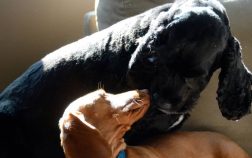Dogs have many varying characteristics but their ears often steal the show. So, what are the 12 different types of dog ears and their unique specifics? Do they matter in any way for your choice or are all differences between them purely cosmetic? What about health concerns? Do different ear types have different care requirements?
Let’s go over all those questions and more below.
The Basic Ear Parts That All Different Types Of Dog Ears Have
Despite how different they look, all dog ears have more or less the same components. It’s just the outer part that looks different. So, without going too deep into the biology of dog ears, here are their basic parts:
- Ear pinna – that’s the outer part of the ear we see and what differs the most in the various dog breeds
- Vertical ear canal – the first major ear canal that leads straight down inside the dog’s ear
- Horizontal ear canal – the second part of the ear canal that makes a shart turn and goes inside the dog’s head
- Tympanic membrane or eardrum – similar to human ears, the eardrum is the first major part of the dog’s hearing mechanism
- Tympanic bulla or the inner ear chamber – the hollow chamber where the eardrum is located
- Hearing organ or internal ear – the actual organ that “hears” sounds that the eardrum is attached to
Of these six components, it’s only the ear pinna that differs between the many dog breeds. Still, while it isn’t a “hearing organ” in a strict sense, the pinna can affect the dog’s hearing if it blocks the ear canal too much which some breeds’ ears do.
In most such cases, however, this isn’t an intentional part of the breeding process but an evolutionary by-product. It’s only for the dog breeds that need excellent hearing that breeders go the extra mile to ensure that their ears remain upright and don’t block the ear canal.
So, with the basics out of the way, let’s go into the dozen or so different types of dog ears.
Find more information about How To Clean Dachshund Ears And Why That’s So Important
The 12 Main Types Of Dog Ears
Most people would typically divide dog ears into just two categories – upright and floppy. And, truth be told, that is the most significant distinction here because floppy ears block the ear canal and partly restrict the dog’s hearing while upright ears don’t.
Still, if we are to go a bit beyond that, there are actually 12 different types of dog ears based on their size, exact shape, and position:
- Bat ears – typical for Corgies, bat ears are extra-large, upright, and triangular. They are fantastic for hearing.

- Blunt-tipped ears – these ears are similar to bat ears but are not as large and not as pointy. Chow Chows and Frenchies are prime examples.
- Button ears – with an erect base and a folded top, button ears are quite cute. Jack Russel terriers sport this type.
- Candle flame ears – worn by English Toy terriers, these ears are extra-long and look like the flame of a candle.
- Cocked ears – Border Collies and pit bulls have such ears – initially upright with a minor bent of the ear at the very top.

- Drop ears – often called just “floppy” ears, this is the ear type of Basset hound and it’s quite sub-optimal for hearing.
- Filbert-shaped ears – these floppy ears can only be seen on the Beddington terrier breed.
- Folded ears – Bloodhounds have these ears. They extend away from the face at first but then quickly dropdown.
- Hooded ears – similar to the prick ears of Huskies, hooded ears are upright but just curve slightly inward.

- Prick ears – common for a lot of terriers, Huskies, and other northern breeds, these ears are upright and averagely-sized.
- Rose ears – this type extends outward from the head almost horizontally before eventually folding and dropping slightly down. They are typical for many sighthound breeds.
- V-shaped ears – common for Labrador retrievers, these ears are V-shaped, flat, and folded over the ear.

Read more about: When Do Dogs Eyes Change Color And What Causes This Amazing Transformation?
Are The Different Dog Ear Types More Or Less Susceptible To Health Problems?
All dog ears are susceptible to infections, especially if the dog loves to swim and/or if you don’t clean your dog’s ears regularly. We mention swimming because trapped moisture is the most common cause of ear infections in dogs.
Still, floppy ear types such as folded, drop, Filbert-shaped, button, and V-shaped ears do trap moisture more often than the upright ear types. So, extra cleaning care is required for these dog breeds. But, even if your dog has upright ears, this doesn’t mean that you should ignore its aural health.
Do The Different Dog Ear Shapes Have Different Health Requirements?
Aside from cleanliness and avoiding ear infections, there isn’t much else you’ll need to do about your dog’s ears, regardless of their shape. Just keep them dry and keep them clean – that’s all!
Studies have found that the dog breeds most likely to develop ear infections are Chinese Shar Peis, Labradoodles, and Basset hounds. As you can see, all three breeds have different ears, however, they are all more or less floppy too.
Are Cropped Ears One Of The Different Types Of Dog Ears?
Yes and no. Cropped ears are not a naturally occurring “ear shape” but are the result of cosmetic otoplasty instead. This procedure involves cutting out large parts of the ear pinna and is usually done between the 7th and 12th week of the pup’s life. Dobermans and American pit bull terriers are the most common recipients of this procedure. However, it’s been quickly falling out of favor in recent years.
Ear cropping was initially done because of the false belief that it reduces ear health problems. However, this has been thoroughly debunked by numerous studies so more and more breeders, experts, and dog owners are not doing it anymore.
In Conclusion, Should You Care About The Type Of Ears Your Dog Has?
Not really, not unless you find some dog shapes and types cuter than others. It is true that floppy ears trap more moisture and can more easily develop ear infections when left uncleaned. However, this doesn’t really mean that you should clean them more. All types of dog ears should be cleaned about once a week regardless of what shape they have.
Read more about: Dog Spinal Surgery Recovery Time – What To Expect And What To Do?




